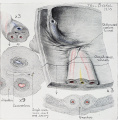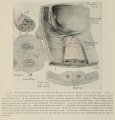File:Cullen1916 fig21.jpg

Original file (1,280 × 1,297 pixels, file size: 530 KB, MIME type: image/jpeg)
Fig. 21. Intra-abdominal View of the Umbilical Region in a Human Embryo 12 cm in Length
(X 3.)
The urachus gradually narrows, but microscopically could be traced as a cord for a considerable distance out into the umbilical cord. In the main it was solid, but here and there appeared to have a lumen. The umbilical vessels now have very well-developed muscular coats, the inner longitudinal layer being especially thick. The umbilical ring shows a puckering, possibly due to the hardening. It is obliterated. Note the oval, funnel-shaped depression between the umbilical arteries and vein. Adherent to the bottom of this is a cord which was attached to a loop of small bowel. This is the remnant of the omphalomesenteric duct or vessels. In the cord the exoccelom is recognized as a slit-like cavity traversed by delicate trabecular of young connective tissue. At one side of this slit is a dense mass of tissue containing the patent omphalomesenteric vessels, and the duct which appeared as a mass of epithelial cells but showed no lumen.
| Historic Disclaimer - information about historic embryology pages |
|---|
| Pages where the terms "Historic" (textbooks, papers, people, recommendations) appear on this site, and sections within pages where this disclaimer appears, indicate that the content and scientific understanding are specific to the time of publication. This means that while some scientific descriptions are still accurate, the terminology and interpretation of the developmental mechanisms reflect the understanding at the time of original publication and those of the preceding periods, these terms, interpretations and recommendations may not reflect our current scientific understanding. (More? Embryology History | Historic Embryology Papers) |
- Figure Links: 1 Human embryo 0.7 mm | 2 Human embryo 1.7 mm | 3 Human embryo 2.5 mm | 4 Human embryo 3.5 mm | 5 Human embryo 5 mm | 6 Human embryo 7 mm | 7 Human embryo 7 mm | 8 Human embryo 10 mm | 9 Human embryo 12.5 mm | 10 Human embryo 10 mm | 11 Human embryo 23 mm | 12 Human embryo 3 cm | 13 Human embryo 4.5 cm sagittal | 14 Human Embryo 4.5 cm | 15 Human Embryo 5.2 cm | 16 Human Embryo 6.5 cm | 17 Human Embryo 7.5 cm | 18 Human Embryo 9 cm | 19 Human Embryo 10 cm | 20 Human Embryo 12 cm | 21 Human Embryo 12 cm | 22 Human Embryo 12 cm | 23 Human Embryo 12 cm Cord | 28 Fetus Five Months | 30 Ventral Heria | 31 Human Embryo 5.5 cm | 32 Term Human | 33 Term Human | [[Figures
Reference
Cullen TS. Embryology, anatomy, and diseases of the umbilicus together with diseases of the urachus. (1916) W. B. Saunders Company, Philadelphia And London.
Cite this page: Hill, M.A. (2024, April 16) Embryology Cullen1916 fig21.jpg. Retrieved from https://embryology.med.unsw.edu.au/embryology/index.php/File:Cullen1916_fig21.jpg
- © Dr Mark Hill 2024, UNSW Embryology ISBN: 978 0 7334 2609 4 - UNSW CRICOS Provider Code No. 00098G
File history
Click on a date/time to view the file as it appeared at that time.
| Date/Time | Thumbnail | Dimensions | User | Comment | |
|---|---|---|---|---|---|
| current | 20:32, 28 October 2018 |  | 1,280 × 1,297 (530 KB) | Z8600021 (talk | contribs) | |
| 20:31, 28 October 2018 |  | 2,082 × 2,176 (1.05 MB) | Z8600021 (talk | contribs) |
You cannot overwrite this file.
File usage
The following 3 pages use this file:
